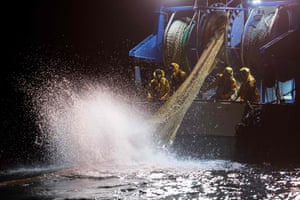Last month Carmelo Isgro received a phone call from the Italian coastguard. A 24ft sperm whale had been found thrashing about in the waters north of Sicily, desperately trying to escape a vast illegal drift net. “They asked me to help cut it loose because I have a lot of experience with these kinds of nets,” says Isgro, a marine biologist and director of the Museum of the Sea in the Sicilian town of Milazzo. “So I got a very big knife and went straight away.”
Isgro was among a team of divers who tried for 48 hours to free the agitated female whale, as the miles-long trap gradually sliced further into her thick skin. “It was a very difficult operation because the whale was so powerful, and if you are struck by its tail you could be killed,” says Isgro. The team were able to remove parts of the netting, but the whale, whose tail was still tangled up, dived deep into the ocean and they lost track.
Authorities say the use of these illegal drift nets, dubbed “walls of death” due to their deadly impact on marine life, has surged. Figures show the Italian coastguard alone has seized 100km (62 miles) of drift nets so far in 2020, compared to 60km in all of 2017, and experts say those numbers are likely to be a major underestimate.
Reaching up to 50km in length and 50m in depth, drift nets – typically made of fine mesh suspended from buoys across fish migration paths – were banned in international waters by the UN in 1992 for any length above 2.5km, due to the high bycatch rates for species of dolphins, whales, sharks and sea turtles. Since 2002 their use has been prohibited in EU waters, no matter the size, when used to capture highly migratory species such as tuna and swordfish.
“The impact of these drift nets is absolutely disastrous,” says Vanya Vulperhorst, campaign director of illegal, unreported and unregulated fishing at Oceana Europe, a conservation non-profit that has investigated illegal drift net fishing across the Mediterranean. “They are indiscriminate in what they trap, and the result is that endangered and protected species are being killed in large numbers.”
Research published last month by Padua University found a quarter of the cetaceans – like the trapped Mediterranean sperm whale, which is endangered – that beached on Italy’s coastline in recent years died due to human activity, with illegal drift nets a primary cause.
Fisheries bycatch, some of which is due to drift nets, accounted for the deaths of more than 300,000 small whales, dolphins and porpoises in 2008, according to WWF, and that figure that is likely to have since doubled. Between 11 and 26m tons of fish, worth up to an estimated $23.5bn (GBP17.9bn), are caught via illegal, unreported and unregulated means every year, according to a 2009 study.

Cheap, profitable and easy to deploy, drift nets remain popular as a commercial fishing method, especially for open sea species such as swordfish, as it allows them to be quickly caught in large quantities.
Campaigners argue that limited and convoluted legislation with a number of loopholes has allowed illegal drift net fishing to thrive. The practice is widely seen in the Mediterranean and has spread across the Atlantic and to the Indian Ocean and the Pacific.
“It’s such a messy set up of laws and regulations and moratoriums,” says Valeska Diemel, international director of FishAct, a non-profit organisation based in Germany. Laws differ between national and international waters, she adds, and practices that are legal in the Atlantic are illegal in the Baltic Sea, where the use and keeping on board of drift nets has been fully banned since 2008. “This is a problem when it comes to enforcement, because there are areas where it is super clear what the laws are, but there are areas where I think agencies aren’t even sure themselves,” she says.
Francesco Mirabito, an environmental activist based in Sicily, says fishermen are also sidestepping sanctions by loading smaller, legal nets known as ferrettara on board and then attaching them together once out at sea.
“In the EU regulations, the definition of the nets is not precise enough,” he says. “Fishermen at the docks are really tranquil, doing everything in daylight because they know they won’t be caught. Then, at sea, they know it’s impossible for authorities to check on all of them. Even if their nets are seized it’s not a big deal – they are made in China for a tenth of the price it used to be.”
A spokesperson for the General Fisheries Commission for the Mediterranean says it “actively supports all efforts to fight illegal, unreported and unregulated fishing”, including regular information requests for countries to ensure legal compliance.
But environmentalists fear governments have been reluctant to impose sanctions on the powerful fishing industries, pointing to a failed effort by the European commission to outlaw the use of any kind of drift net for fishing in EU waters. Greenpeace was among the signatories of a letter last month to Italy’s minister of agriculture Teresa Bellanova asking for an outright ban on drift nets and powerful sanctions for lawbreakers.
“This destruction is happening before our eyes,” says Raul Garcia, fisheries officer at WWF Spain, who has been researching drift nets since 2002. “It has been for years. We need to act before it’s too late.”